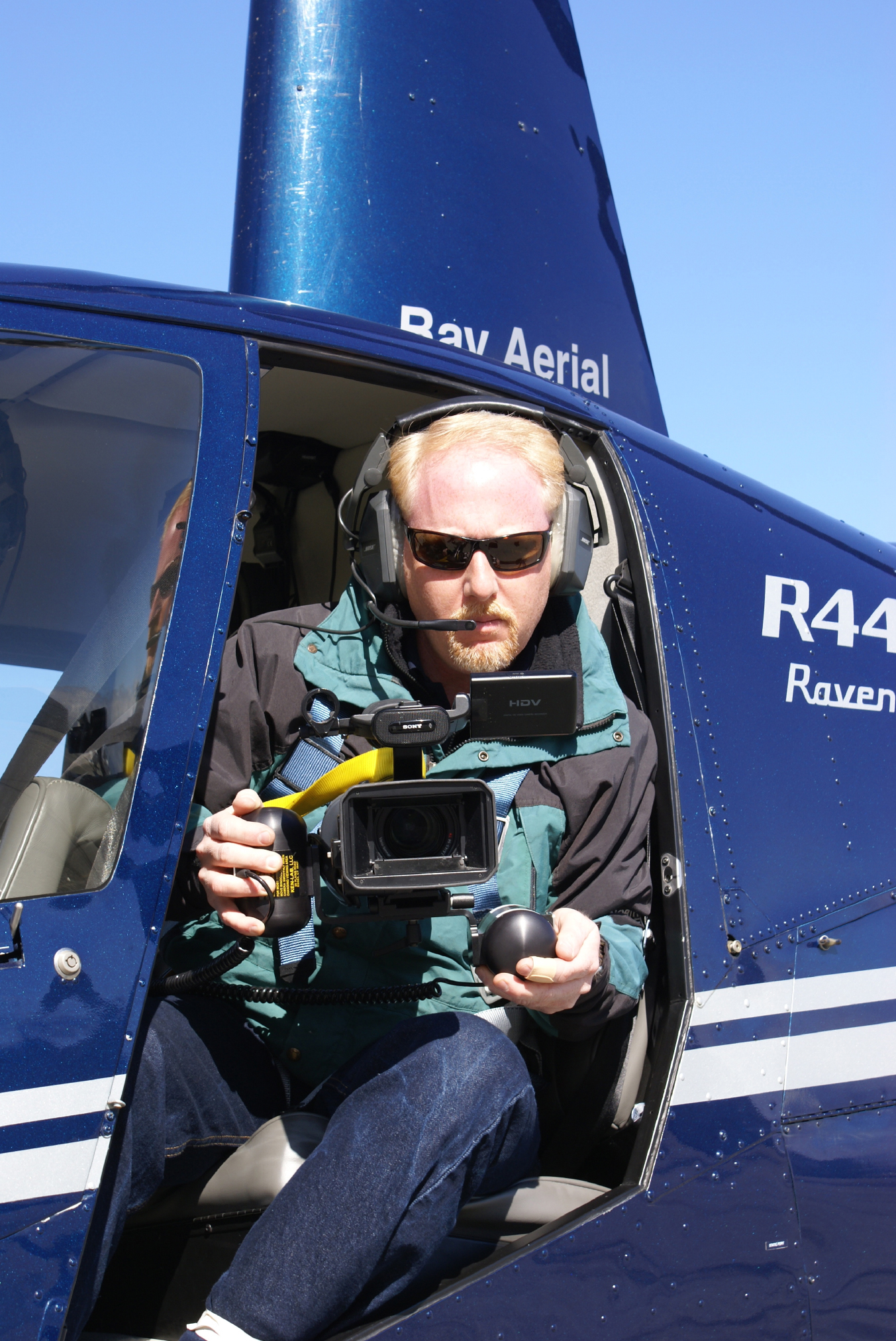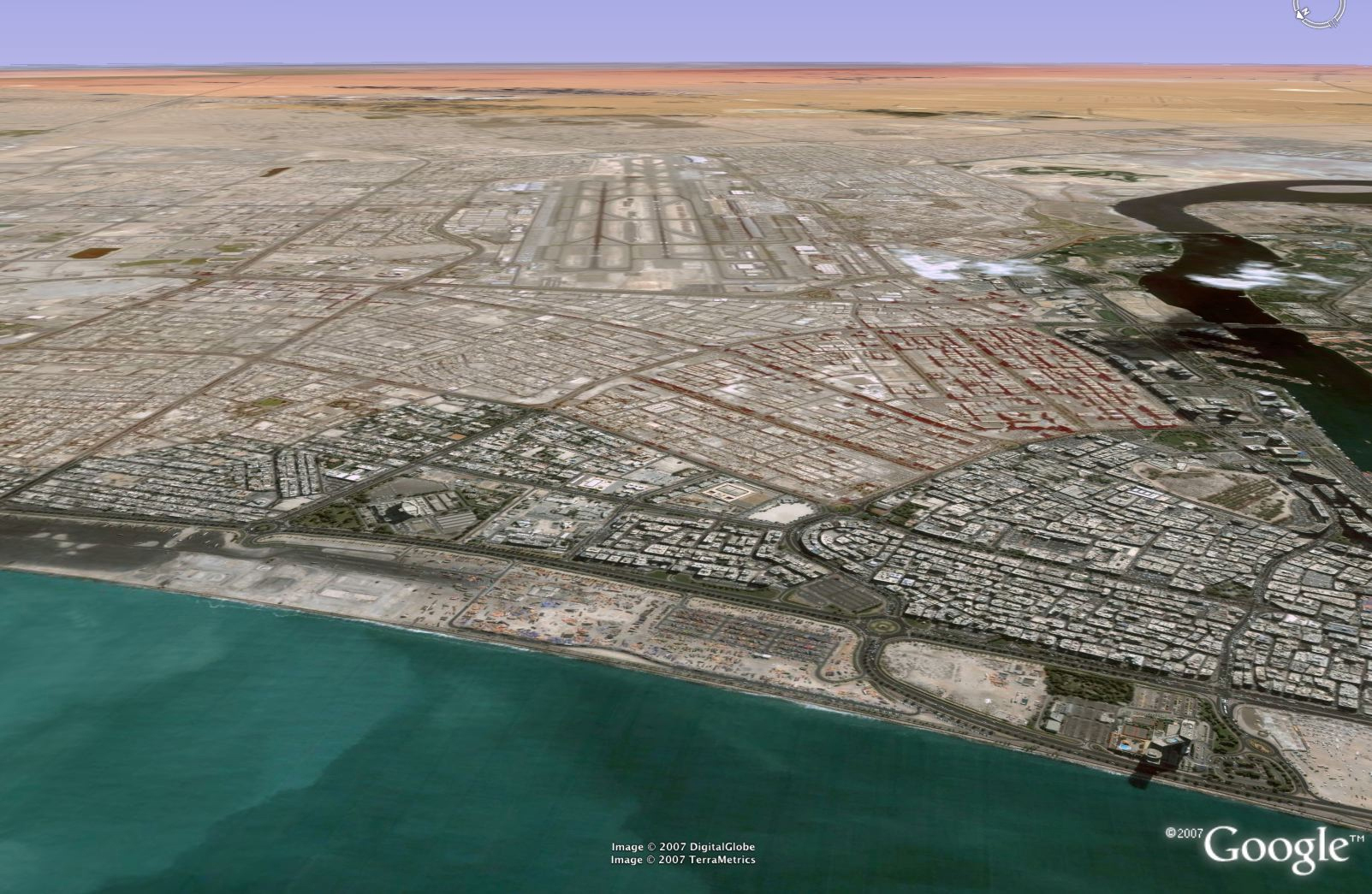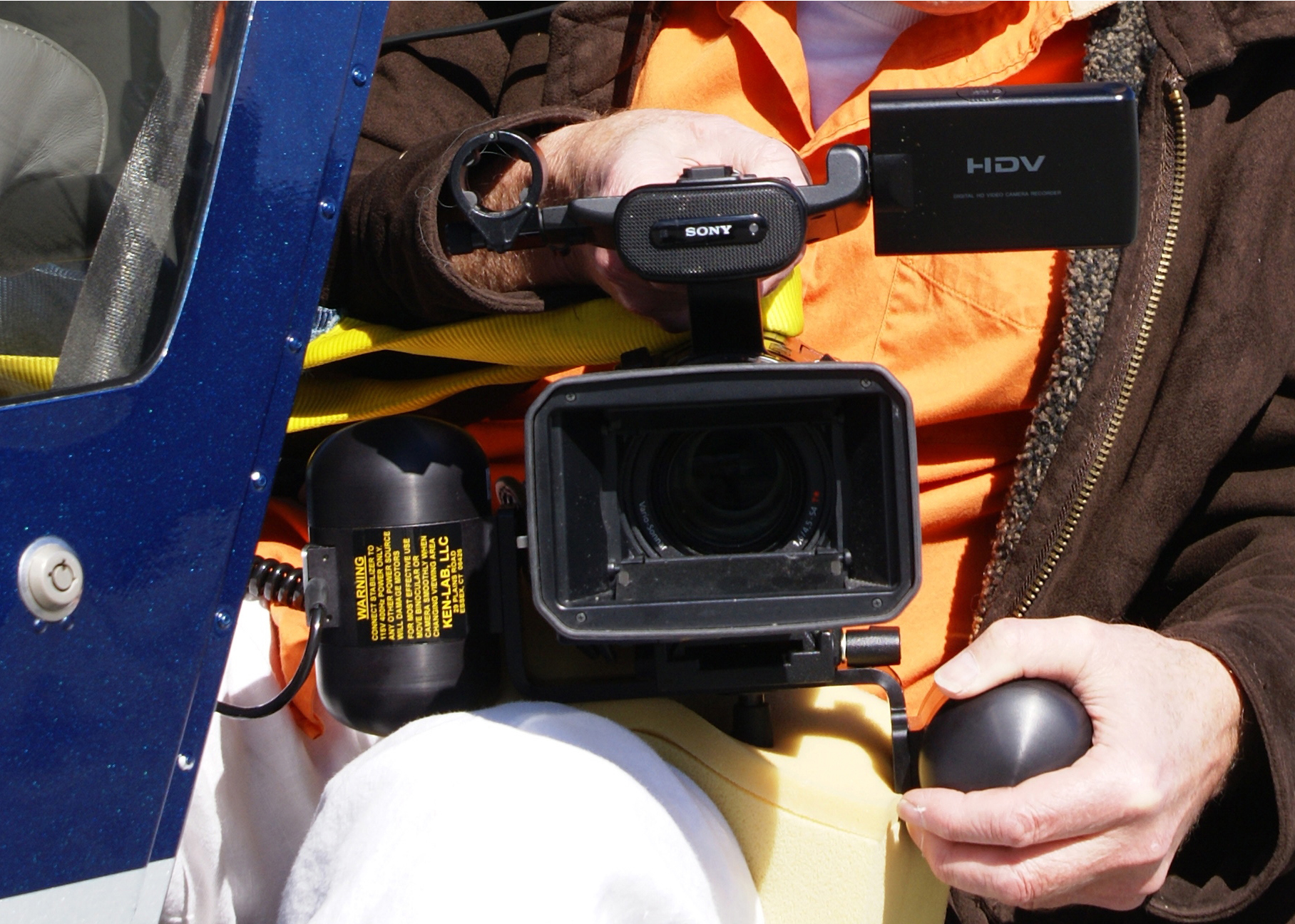August 2006, San Francisco. My client shows me the budget for a new corporate video.
“That’s great. You’re getting an aerial cameraman. Good idea to hire a specialist.”
“No, that’s you. You’re our helicopter cameraman. You told me you’ve done it before.”
Tell him how you screwed them up. Tell him about the shoot in Dubai when you dropped half the camera in the Persian Gulf. Or the one in Leeds, when you shot the wrong housing estate. Or the helicopter shoot for the British Army where the convoy completely disappeared into dense civilian traffic and you had nothing to film.
“You know, I was just thinking how well the Birds Eye Pea film went.”
Shame on you Stefan. Sure you had usable aerial footage, but the pilot was a loony who flew so close to the ground that you had your eyes closed most of the time….

Tom Miller of Blue Sky Aerials (www.blueskyaerials.com) hand-holds the gyro-mounted camera and wears a safety harness. This lets him lean right out of the 'copter. While he has great camera freedom, he's facing into a 50 mph wind. Not for me. I'll stay inside, rest the camera on my knee, and wear a seat belt.
December 1975, Dubai, UAE. I am making a film for an Iranian architect. He has designed a tall hotel to be built at the mouth of the Dubai Creek. The architect wants me to shoot buildings in old Dubai to show how his design incorporates ancient with modern. He also wants the view from the rotating restaurant at the top.
It seems impossible to get a helicopter. The only helicopter is owned by the Emir himself. I am booked for a 5-day shoot and I have no return ticket!
“I want to go home. Please get me a ticket. It’s Christmas. I miss my wife and child.”
But I’m stuck. After two weeks I climb aboard the ‘copter from atop the palace. I am in a monkey suit so I can stand outside the cockpit. If I fall I’ll just dangle.
We fly all over Dubai. I have an ƒclair NPR 16 mm camera. There’s so much wind and cold and primeval fear that I just point the camera down and shoot away.
Pretty soon we’re in position and altitude for shooting the top of the new hotel. Helicopters are not good at staying still in one place, and the shot is less than exciting. About 180 degrees of the view is the Gulf itself-just water. The other half is Dubai, which is no Paris. The ‘copter is doing 360s. I feel the camera vibrating. I keep wanting to do another 360-maybe slower this time.
Helicopter pilot to rookie cameraman: “We gotta get outta here. This is a dangerous spot.” Dangerous? The pilot flew in Vietnam.
“If you look left in the distance-see the airport, way over there. Now look right and up. That’s a 747 coming in to land. We are slap bang in the flight path. Hang on.”
We spin around. An ƒclair 400-foot film magazine shoots off the seat and into the Gulf-about $5,000 gone overboard, not to mention 10 minutes of exposed film.
Safely on the ground, I tell the architect that his precious hotel is directly in the flight path of an airport runway. He breaks down and cries.

Google Earth of Dubai. The international airport is dead center. The doomed hotel's rotating restaurant was to be 60 stories high on the coast and directly in the flight path.
August 2006, San Carlos Airport, California. I turn up early for my latest date with a whirlybird to meet aerial cameraman and gyro specialist, Tom Miller of Blue Sky Aerials.
“Tom, I need help. I’ve done four aerial shoots and three and a half were embarrassing failures. Any tips?”
Tom climbs into the ‘copter and puts on a harness that allows him to lean right out of the ship. He’s cool and calm.
“Make sure you know how to speak to the pilot. Left pedal, right pedal. Ten o’clock, one o’clock. Airspeed and distance to subject. Say to the pilot, ‘Okay, let’s fly around that tanker at 200 feet. Keep me at around 55 knots.’
“As the tanker passes from my left to my right, ask the pilot to give you some right pedal. This will swing the ship to the right allowing you more right pan,” Tom explains.
“The pilot can really pan for you,” he goes on. “Then say something like, ‘That was great, but let’s lose around 100 feet and slow it to 45 knots and repeat the move.'”
“Tom, I can’t say that-I have no idea about airspeed and height. The pilot will laugh at me. Tell me how I shoot straight ahead.”
“Put on the harness, lean out of the ‘copter, and angle the camera forward. Have the pilot put the helicopter slightly out of trim,” Tom says.
“No way-I’m staying inside.”
I then meet my pilot, John du Gan of Bay Aerial (www.bayaerial.com). I show him a photo and the architect’s plan.
“John, I know nothing about airspeed or pedal left and right. I just need to shoot flying straight in and match it to this drawing.”
John is straight out of Central Casting. He’s the honest, silent, no-nerves pilot. On the way to the location he plays country music from his iPod.
“Do you have ‘Ride of the Valkyries?'” He doesn’t.
John spends some time flying over vineyards looking for a flag. He needs the direction and strength of the wind. He finds a flag. There’s no wind. Good. I’m relaxed. I can do this.
“Let’s fly down the river and then move into the target.”
The Ken-Labs dual-axis gyro unit sits on a rubber pad in my lap. My Sony HVR-Z1 is fixed to the unit and safely chained to a bar. The camera is heavy but solid. I switch on the gyros and can feel them working.
“We’re going in at 500 feet.”

Blue Sky Aerials' Micro Gyro Mount HDV-K4, a custom rig based on Ken-Labs stabilizer technology, with my Sony Z1. To buy the mount is $4,200, but you can rent it at $75 a day, $225 per week. The foam pad on my knee works well. There's a yellow safety cord looped around a bar.
John flies the ship like no other pilot I’ve worked with: sideways, crabbing the craft so that my camera is almost facing forward. It feels good. We do four runs. I have stuck two small bits of paper to my Sony viewfinder. When they line up with the target, I know the shot will match the drawing.
The shoot has cost $1,500 for John and the ship. Just $75 for the gyros. Can’t wait to see it. Back in the edit room, take one is the best, but it’s just not as steady as I had hoped for. I transfer the HDV shot into Final Cut Pro, export as an HD QuickTime movie, and import that into Apple Shake.(I’d rather do this than use FCP’s export-to-Shake feature.)
I put the shot into Shake’s Smoothcam node. Because Shake is fixing the camera movement, it’s lifting the shot up and down and from side to side. To get rid of the black edges, I run the shot through Shake’s size node and make it 7 percent bigger. Now I export the stabilized HD shot using the Animation codec. I import this into QuickTime Pro and export using the NTSC DV setting. Lastly I import to Final Cut Pro, which is now reset from HDV to plain old DV widescreen, and admire my handiwork.
Because I did the processing in HD, the quality hasn’t suffered-it’s perfect. You can see before and after Shake at www.stefansargent.com/helicopter.html.
My first real aerial shooting success. But all the credit goes to Tom for his gyros, John for great flying, and finally to Shake, which unshook it.
